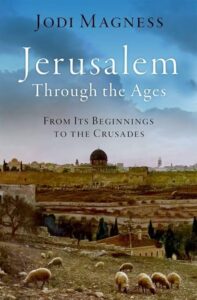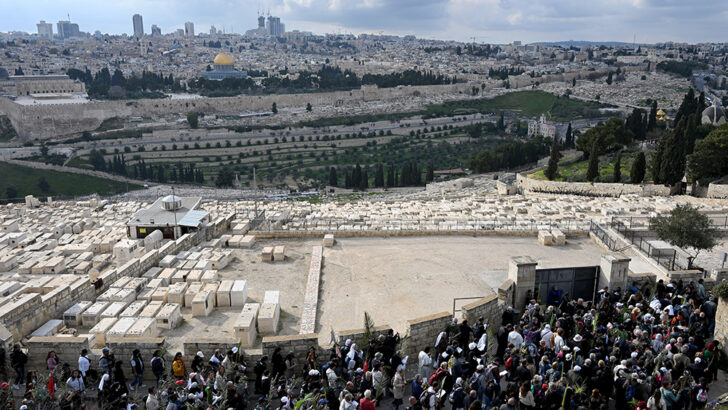Jerusalem Through the Ages: From its Beginnings to the Crusades
by Jodi Magness (Oxford University Press, £30.99/€36.50)

Author Jodi Magness is a distinguished archaeologist at the height of her career who specialises in ancient Palestine from its beginnings up the Middle Ages. Over several years she had to be persuaded to write this book, but many readers will find her account of Jerusalem’s long journey through time as she reveals it quite fascinatingly and absorbingly.
She is currently engaged in directing an extended excavation of a small village since 2011 Huqoq, a little to the north of Tiberias, near the Sea of Galilee, where layer by layer the cultural history of a region can be traced back in time.
In this book she applied the same archaeological technique to the city of Jerusalem. Most accounts of the city use archaeology to illuminate the ancient texts and historical accounts. But Prof. Magness works on the principle that the texts may, or may not, as the case may be, illustrate what the archaeology demonstrates.
Jerusalem being important in the thinking of some four faiths, Jewish, Christian, Muslim and Druze, archaeology can often be quite as controversial as politics, very often is a form of politics. People are prepared to fight over what they believe, to defy any authority, and to ignore the wider world.
History
In all of this it is worth remembering that it was really only in the course of the 19th century that truly scholarly investigation began in Palestine. To many it seemed unchanged since Old Testament times.
The evocative lithographs of David Roberts from the 1850s seemed also to provide a setting for King David and Jesus and the Apostles. But time has shown how much older they really are. The earliest date given here is 3,500 BCE when bronze age Jerusalem was settled.
Magness, keeping within her professional area, ends her narrative abruptly with the city’s surrender by the Crusaders to Saladin. They had held the city since 1099 – a mere 88 years. Yet as she says the Crusaders had imposed themselves on the city in a lasting way in that short time.
“To ignore this is to leave out a very important aspect of the city’s history”
She has a brief coda with the victorious entry of General Allenby on 11 December 1917, which was pure political theatre for the photographic media of the day.
But I was surprised by this arrangement. She leaves aside the half a millennium of influence on the city which was provided by the Ottoman Empire. The Palestine that those first scholars, artists and photographers recorded in the Victorian era saw a city that the Turks had also had a large hand in shaping. To ignore this is to leave out a very important aspect of the city’s history.
After all, while the Ottoman Empire was supposedly tottering, it still survived. Indeed, the Crimean War of 1853-56 was fought over the city of Jerusalem and the rights there of the Russians as opposed to the British and French, it was a matter of Orthodox versus Protestant and Catholic.
Religion
A sort of rehearsal for a world war, the battles were fought in the Black Sea, the Baltic and the Far East; but the object of the war was Jerusalem. To understand the British Mandate one has to always keep in mind the Ottomans. Today Russia and Turkey are still involved in the area.
But this lament probably carries little weight with the author, for her interest is in the Jerusalem of the Jews, the Christians and the early Muslims – as are the interests of most visitors today.
Indeed, she reveals chapter by chapter aspects of the city many visitors may never see. She wants to describe what can be seen over ground along with what has been found underground. The text and the illustrations take the readers into many strange places and curious corners.
“She unravels the complicated story stage by stage in a very detailed but understandable way”
I think it is a book to sit on your shelves beside William Foxwell Albright’s classic From Stone Age to Christianity: When Israel invaded the West Bank and occupied Jerusalem in 1969, an Israeli archaeologist observed that the Christians had had their say for too long. Now it was Israel’s turn. Archaeology is at the heart of the Jewish perception of the city.
However, the development of Jerusalem has to be centred on what was created on what is now called the Temple Mount, which is the essential holy place for Jews and Muslims. It is a place of constant friction and periodic rioting. But she unravels the complicated story stage by stage in a very detailed but understandable way. For some these chapters will be the heart of the book.
Jesus
But over a series of four chapters (covering 64 BCE to 634 CE) she covers the archaeology of the New Testament and early days of Christianity in some detail. (In the course of all this she even has some paragraphs on RAS Macalister, the Irish archaeologist, who had worked in Palestine before becoming Professor of Celtic Archaeology in UCD in 1909. Alas, she is quite brisk with him for “digging hastily and carelessly”. He and others might have, I imagine, a robust retort or two to such a sweeping remark. He made many discoveries at Gezer, and wrote a book about it, and was the first to apply the new methods Flinders Petrie developed in Egypt based on pottery dating sequences to Palestine.)
In her seventh chapter, however over pages 182-191, she explains why there are no archaeological remains relevant to Jesus: he was simply too poor to leave any traces of his life. She disposes as she does so with such media controversies as “The James Ossuary” and “The Talpiyo Tombs” .
She also discusses the circumstances, which might perhaps have been filled out more, of the execution and burial of Jesus, and with the death and burial of James “the Brother of the Lord”.
“What it was in the past, what it is today, are not necessarily what it will be tomorrow”
This is a book for everyone interested in Palestine and Jerusalem for scholarly reasons, but one which those with a more general interest will greatly enjoy.
It reveals aspects of life and history in Palestine, often in smallest details, that enlarge one’s ideas about the city and its region. But it is a book that requires careful reading nevertheless.
Jerusalem is an important place and has been for millennia. But it is still changing and evolving. Its history is by no means finished. Like all places and all peoples it does not need to be bound to what happened in the past – or was supposed to have happened. What it was in the past, what it is today, are not necessarily what it will be tomorrow.


 Peter Costello
Peter Costello Christians walk the traditional path that Jesus took on his last entry into Jerusalem during the Palm Sunday procession on
the Mount of Olives in Jerusalem March 24, 2024. Photo: OSV News/Debbie Hill.
Christians walk the traditional path that Jesus took on his last entry into Jerusalem during the Palm Sunday procession on
the Mount of Olives in Jerusalem March 24, 2024. Photo: OSV News/Debbie Hill. 